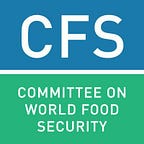CFS 44–44th Session of the Committee on World Food Security
The chicken or the egg?
“I started with just 100 chickens”, begins Mr Jean Claude Ruzibiza
He goes on to explain how from small beginnings he has now become Managing Director of Rwanda Best, a farm producing 4,500 eggs a day and growing fruit and veg to satisfy a significant part of nearby Kigali’s hungry population.
With malnutrition in the world causing the stunting of an estimated 155 million children in 2016 the quality of food consumed is as imperative as its quantity.
This got me thinking about the chicken and egg debate. What comes first in changing dietary behaviour, demand or supply? Consumers or growers?
“The issue is not market forces that are overriding nutritional behaviour”, stresses Mr. Olivier Habimana from Rwanda Development Organisation, my second post side event interview, “it is just one piece of the puzzle that is not yet crafted”, he continues
From the point of view of an individual smallholder farmer in Rwanda, Mr Habimana helps me to understand the dilemma many farmers face in the region. Whether to save some crop for a more balanced diet in the coming months or to sell it all to pay for immediate family essentials. Mr Habimana’s programme in Rwanda is working at this level to provide farmers with the basic educational tools to understand how markets and global food value chains affect them.
With this knowledge they can make better informed decisions on the best time to sell their produce to market. The consequence is to balance the need for financial stability and a healthy diet. In this sense more of the food (and nutritional) value chain is captured at household level.
I spoke to Mr Ruzibiza and Mr Habimana after the CFS44 side event on Market development for nutrition: Best Practices and Policies to develop Food Systems for Improved Nutrition at Scale, Case Studies from Uganda, Zambia and Rwanda. An important take-away from the event expressed the need to restructure the single commodity approach to food markets. Instead looking at how the value chains of staples, fruit and vegetables, dairy and meat can overlap to meet the nutritional needs of marginalised and impoverished consumers. Therefore those all along the value chain are integral to dietary behaviour change and combating malnutrition.
Returning to my original question of what comes first in changing dietary behaviour, demand or supply? Consumers or growers? The CFS44 side event was clear in calling for change makers to rethink local and global food markets to give smallholder farmers greater autonomy over their growing and consumption behaviours. You could say the consumer is always king, but the supplier is pulling the strings.
As for the chicken and the egg debate. Well, let’s just say Mr Ruzibiza started with 100 chickens
Blogpost by Teddy Searight, #CFS44 Social Reporter — T.Searight(at)cabi.org
Photo credit: Ruben Alexander on Flickr
This post is part of the live coverage during the 44rd Session of the Committee on World Food Security. This post is written by one of our social reporters, and represents the author’s views only.
Originally published at www.fao.org.
